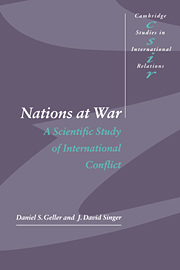Book contents
- Frontmatter
- Contents
- List of figures and tables
- Acknowledgements
- Introduction
- 1 Overview
- 2 Decision models
- 3 War-prone states
- 4 War-prone dyads
- 5 War-prone regions
- 6 War-prone systems
- 7 Case study: Iran/Iraq War (1980)
- 8 Case study: World War I (1914)
- 9 Conclusion
- Appendix 1 List of databases
- Appendix 2 Tables of references by category
- References
- Index
- Cambridge Studies in International Relations
3 - War-prone states
Published online by Cambridge University Press: 16 October 2009
- Frontmatter
- Contents
- List of figures and tables
- Acknowledgements
- Introduction
- 1 Overview
- 2 Decision models
- 3 War-prone states
- 4 War-prone dyads
- 5 War-prone regions
- 6 War-prone systems
- 7 Case study: Iran/Iraq War (1980)
- 8 Case study: World War I (1914)
- 9 Conclusion
- Appendix 1 List of databases
- Appendix 2 Tables of references by category
- References
- Index
- Cambridge Studies in International Relations
Summary
Introduction
This chapter focuses on quantitative empirical research relating to the war-proneness of states at the analytical level of the state. The distinction between the search for causal factors associated with state behavior at the aggregate level of interacting units (dyad/system) or at the level of the acting unit alone (state) was initially described by Waltz (1959) and Singer (1961), and elaborated by Waltz (1979). State- and subnational-level factors presumably associated with foreign policy behavior include governmental variables such as political system-type, the distribution of influence within regimes, bureaucratic characteristics, organizational processes, and electoral cycles. Economic elements postulated to affect the foreign policies of states include the structure of the economic system, business cycles, level of economic development, and the pool of national capabilities that constitute or contribute to military and economic power. The impact of many of these factors on state-level behavior has been explored through the comparative analysis of foreign policy utilizing the Snyder, Bruck and Sapin (1962), Rosenau (1966), and Andriole, Wilkenfeld and Hopple (1975) analytical frameworks.
Issues surrounding rational and nonrational decisionmaking models have been discussed in chapter 2. As noted in that chapter, there is an extensive literature on the impact of psychological characteristics and cognitive processes of decisionmakers on foreign policy choices. In this area, factors such as perception, belief-system, cognitive dissonance, displacement, and the nexus between frustration and aggression are hypothesized to affect patterns of international conflict and war.
- Type
- Chapter
- Information
- Nations at WarA Scientific Study of International Conflict, pp. 46 - 67Publisher: Cambridge University PressPrint publication year: 1998



